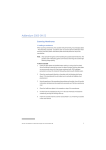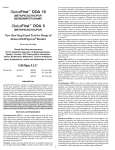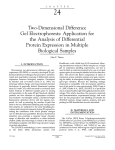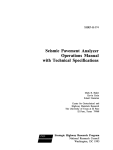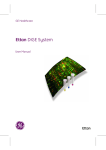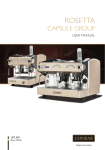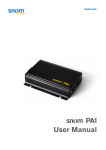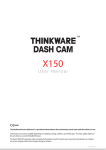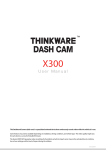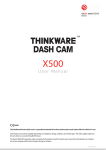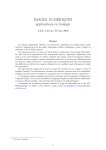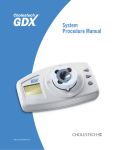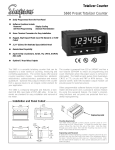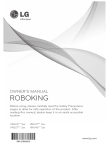Download Amersham™ CyDye DIGE Fluors - GE Healthcare Life Sciences
Transcript
Amersham™ CyDye DIGE Fluors (minimal dyes) for 2D DIGE Reagents for labeling protein with Cy2, Cy3 and Cy5 dyes, before 2-Dimensional separation Product Booklet Codes:RPK0272 25-8008-60 RPK027325-8008-61 RPK027525-8008-62 25-8010-65 25-8010-82 25-8010-83 25-8010-85 28-9345-30 Page finder 1.Legal 3 2. Handling 2.1. Safety warnings and precautions 2.2. Storage 2.3. Expiry 5 5 5 5 3. Components6 4. Other materials required 7 5.Description 9 6. Protocol12 6.1. Introduction 12 6.2. Preparation of a cell lysate compatible with CyDye DIGE 12 minimal labeling 6.3. Reconstitution of CyDye in Dimethylformamide (DMF) to give a stock solution 14 6.4. Preparation of CyDye solution used to label proteins 15 6.5. Minimal labeling a protein sample 16 6.6. Loading samples onto IPG strips 17 7. Additional information 7.1. Requirements for 2D DIGE protein lysis buffer 7.2. Requirements for a cell wash buffer 7.3. Cell sonication 7.4. Adjustments of protein sample pH 7.5. Testing a new protein lysate for successful labeling 7.6. Post-staining with Deep Purple Total Protein Stain 7.7. Reagents tested with 2D DIGE 18 18 18 19 20 20 22 25 8. Troubleshooting guide27 9. Related products 31 2 1. Legal GE, imagination at work and GE monogram are trademarks of General Electric Company. Amersham, Cy, CyDye, DeCyder, Deep Purple, Ettan, ImageQuant, IPGphor, Immobiline, Multiphor, Pharmalyte, PlusOne and Typhoon are trademarks of GE Healthcare companies. 2-D Fluorescence Difference Gel Electrophoresis: 2-D Fluorescence Difference Gel Electrophoresis (2D DIGE) technology is covered by US patent numbers 6,043,025, 6,127,134 and 6,426,190 and equivalent patents and patent applications in other countries and exclusively licensed from Carnegie Mellon University. CyDye: this product or portions thereof is manufactured under an exclusive license from Carnegie Mellon University under US patent numbers 5,569,587, 5,627,027 and equivalent patents in other countries. The purchase of CyDye DIGE Fluors includes a limited license to use the CyDye DIGE Fluors for internal research and development, but not for any commercial purposes. A license to use the CyDye DIGE Fluors for commercial purposes is subject to a separate license agreement with GE Healthcare. Complete is a trademark of Roche Sigma is a trademark of Sigma-Aldrich Co. Prefabloc is a trademark of Pentapham Ltd. Triton is a trademark of Union Carbide Chemicals and Plastic Company Inc. © 2002–2013 General Electric Company - All rights reserved. Previously published 2002. All goods and services are sold subject to the terms and conditions of sale of the company within GE Healthcare which supplies them. A copy of these terms and conditions is available on request. Contact your local GE Healthcare representative for the most current information. 3 http://www.gelifesciences.com GE Healthcare UK Limited. Amersham Place, Little Chalfont, Buckinghamshire, HP7 9NA, UK 4 2. Handling 2.1. Safety warnings and precautions CAUTION: This dye is intensely colored and very reactive. Care should be exercised when handling the dye to avoid staining clothing, skin, and other items. The toxicity of Cy™2, Cy3 and Cy5 NHS Esters has not yet been evaluated. Warning: For research only. Not recommended or intended for diagnosis of disease in humans or animals. Do not use internally or externally in humans or animals. Warning: All chemicals should be considered as potentially hazardous. We therefore recommend that this product is handled only by those persons who have been trained in laboratory techniques and that it is used in accordance with the principles of good laboratory practice. Wear suitable protective clothing such as laboratory overalls, safety glasses and gloves. Care should be taken to avoid contact with skin or eyes. In the case of contact with skin or eyes wash immediately with water. See material safety data sheet(s) and/or safety statement(s) for specific advice. 2.2. Storage Store at -15°C to -30°C. Avoid light, store in the dark. 2.3. Expiry For expiry date see outer packaging. 5 3. Components RPK0272: 25 nmol (5 × 5 nmol) of CyDye™ DIGE Fluor Cy2 minimal dye RPK0273: 25 nmol (5 × 5 nmol) of CyDye DIGE Fluor Cy3 minimal dye RPK0275: 25 nmol (5 × 5 nmol) of CyDye DIGE Fluor Cy5 minimal dye 25-8008-60: 10 nmol (2 × 5 nmol) of CyDye DIGE Fluor Cy2 minimal dye 25-8008-61: 10 nmol (2 × 5 nmol) of CyDye DIGE Fluor Cy3 minimal dye 25-8008-62: 10 nmol (2 × 5 nmol) of CyDye DIGE Fluor Cy5 minimal dye 25-8010-65: 5 nmol of CyDye DIGE Fluor minimal labeling kit (Cy2, Cy3 and Cy5) 25-8010-82: 5 nmol of CyDye DIGE Fluor Cy2 minimal dye 25-8010-83: 5 nmol of CyDye DIGE Fluor Cy3 minimal dye 25-8010-85: 5 nmol of CyDye DIGE Fluor Cy5 minimal dye 28-9345-30: 2 nmol of CyDye DIGE Fluor minimal labeling kit (Cy2, Cy3 and Cy5) 6 4. Other materials required Reconstitution of CyDye 99.8% anhydrous Dimethylformamide (DMF) less than 3 months old from day of opening (Sigma-Aldrich 22,705-6) Labeling • Microfuge tubes 1.5 ml • S tandard Cell wash buffer, 10 mM Tris (pH 8.0), 5 mM Magnesium Acetate. Store in aliquots at -15°C to -30°C. • L ysis buffer 30 mM Tris, 7 M Urea, 2 M Thiourea, 4% (w/v) CHAPS. Adjust to pH 8.5 with dilute HCl. Aliquots can be stored at -15°C to -30°C. • Lysine 10 mM L-Lysine (Sigma-Aldrich L-5626) • pH indicator strips (Sigma™ pH test strips pH 4.5–10.0 P4536) For additional protocols • 2 × Sample buffer 8 M Urea, 130 mM DTT, 4% (w/v) CHAPS, 2% (v/v) Pharmalyte™ 3-10 for IEF. Aliquots can be stored at -15°C to -30°C. ehydration buffer • R 8 M Urea, 4% (w/v) CHAPS, 1% (v/v) Pharmalyte 3-10 for IEF 13 mM DTT odium Hydroxide • S 50 mM NaOH × Gel loading buffer • 2 120 mM Tris (pH 6.8), 20% (v/v) (87% [v/v] Glycerol), 4% (w/v) SDS, 200 mM DTT and a few grains of Bromophenol Blue. 2.5% Acrylamide gel (for SE600) 32 ml Acrylamide/Bis 40% (v/v), • 1 25 ml Tris (1.5 M pH 8.8), 1 ml SDS 10% (v/v), 1 ml Ammonium Persulfate 10% (w/v), 40 µl TEMED. Make up to 100 ml with distilled water. 7 • 1 × SDS electrophoresis running buffer 25 mM Tris, 192 mM Glycine, 0.2% SDS. Store at room temperature. 8 5. Description 2D Fluorescence Difference Gel Electrophoresis (2D DIGE) is a method to label proteins with CyDye Fluors that are subsequently separated using 2-Dimensional gel electrophoresis. This protocol is specifically designed to work using CyDye DIGE Fluors. The 2D DIGE technology is designed to simplify the process of detecting and identifying proteins using the 2-D electrophoresis technique by allowing the separation of up to three different protein samples in the same 2-D gel. Each of the three protein samples are labeled with one CyDye. After labeling the three samples are mixed together and run on the same Isoelectric focusing (IEF) and SDS PAGE gel. The ability to multiplex different samples on the same gel means that the different samples will be subject to exactly the same 1st and 2nd dimension running conditions so the same protein labeled with a CyDye will migrate to the same position on the 2-D gel, this helps limit experimental variation. Each of the individual samples can then be visualized independently by selecting the individual excitation and emission wavelengths for each CyDye when fluorescence scanning. Experimental design The experimental design recommended is based on evidence that the experimental variation in a 2-D gel electrophoresis experiment is mostly due to gel to gel variation. Running multiple samples on a single gel reduces the number of gels required to produce the same number of data sets. The recommended protocol suggests that an internal standard sample be run on all gels within an experiment. The standard sample is generated by mixing together an aliquot of all the different samples in an experiment. This means that every protein from every sample will be represented in the standard that is present on all the gels. The standard sample will increase 9 the confidence in matching between gels and will also allow the generation of accurate spot statistics between gels. When using DeCyder™ 2D software use the experimental design outlined below. The example given is for protein samples, one derived from a control tissue and one a diseased tissue: Mix 1/3 of each of the control and diseased samples together to create a standard sample. Label the standard sample with Cy2. Label the remaining 2/3 of the control sample with Cy3. Label the remaining 2/3 of the diseased sample with Cy5. More complex experimental designs can be generated using the standard sample on all gels. Minimal labeling CyDye DIGE Fluors have an NHS ester reactive group, and are designed to covalently attach to the epsilon amino group of lysine of proteins via an amide linkage. The quantity of dye added to the sample is limiting in the reaction hence this method is referred to as ‘minimal’ labeling. This ensures that the dyes label approximately 1–2% of the available lysine and then only on a single lysine per protein molecule. The three dyes are matched for size and charge such that the three labeled protein samples are all run on the same 2-D gel the same protein labeled with each CyDye will overlay. The lysine amino acid in proteins carries a +1 charge at neutral or acidic pH. CyDye DIGE Fluors also carry an intrinsic +1 charge which, when coupled to the lysine, replaces the lysine’s +1 charge with its own, ensuring that the pI of the protein does not significantly alter. CyDye DIGE Fluors when coupled to the protein add approximately 500 Da to the protein’s mass in a uniform manner, giving an image comparable to equivalent silver stained gels in existing databases. 10 Spot picking To spot pick from a gel containing CyDye labeled samples, post stain the gel with Deep Purple to ensure that the majority of unlabeled protein is picked to give sufficient protein for MS identification. The migration difference between the unlabeled and labeled protein is due to the addition of a single CyDye molecule to the protein. This is more significant for low molecular weight proteins. Protein identification CyDye labeling of proteins does not affect the mass spectrometry data used to identify proteins as only 1–2% of lysine residues are labeled on a single protein. CyDye labeling of the lysine will only result in the loss of a single trypsin digest site per labeled protein. 11 6. Protocol 6.1. Introduction This protocol provides all the information required to use CyDye DIGE Fluors to label proteins for 2-D electrophoresis experiments. It is recommended that the protocol is read thoroughly before using the system and that it is followed precisely. Reagents tested with 2D DIGE are listed on page 25–26. In the standard labeling protocol, proteins are first solubilized in a lysis buffer. The protein concentration should then be determined using a standard protein quantitation method. CyDye DIGE Fluors are then added to the protein lysate so that 50 µg of protein is labeled with 400 pmol of fluor. The reaction is incubated on ice in the dark for thirty minutes. When handling proteins it is important to keep them on ice at all times to reduce the effect of proteases, and use plastic tubes as many proteins will adhere to glassware. The fluorescent properties of Cy2, Cy3 and Cy5 can be adversely affected by exposure to light, so it is recommended that all labeling reactions are done in the dark, in microfuge tubes, and the exposure of protein labeled with CyDye to all light sources is kept to a minimum. 6.2. Preparation of a cell lysate compatible with CyDye DIGE minimal labeling The example given here is that used with an Escherichia coli model system (See Ettan DIGE user manual for more details). Recommendations for different cell types are listed on page 24. Approximately 4 × 1010 E. coli cells will result in a 5 to 10 mg/ml of protein in 1 ml of lysis buffer. 12 1. Pellet the cells in a suitable centrifuge at 4°C. 2. Pour off all growth media, taking care not to disturb the cell pellet. 3. Resuspend cell pellet in 1 ml of standard cell wash buffer in a microfuge tube. 4. Pellet the cells in a microcentrifuge at 12 000 × g for 4 minutes at 4°C. 5. Remove and discard the supernatant. 6. Resuspend cell pellet in 1 ml of standard cell wash buffer in a microfuge tube. 7. Repeat steps 4 to 6 at least three times. 8. Ensure all the wash buffer has been removed with a fine pipette. 9. Resuspend the washed cell pellet in 1 ml of lysis buffer (30 mM Tris, 7 M Urea, 2 M Thiourea, 4% (w/v) CHAPS, pH 8.5) and leave on ice for 10 minutes. Note: if the protein concentration is less than 5 mg/ml after protein quantitation, resuspend cells in a correspondingly smaller volume of lysis buffer in subsequent experiments. 10. Keep the cells on ice and sonicate intermittently until the cells are lysed. See ‘Cell sonication’, page 19. 11. Centrifuge the cell lysate at 4°C for 10 minutes at 12 000 × g in a microcentrifuge. 12. Transfer supernatant to a labeled tube. This is the cell lysate to be used for CyDye labeling. Discard the pellet. Check that the pH of the cell lysate is still at pH 8.5 by spotting 1 µl on a pH indicator strip. If the pH of the cell lysate has fallen below pH 8.0 then the pH of the lysate will need to be adjusted before labeling. See ‘Adjustment of protein sample pH’, page 20. Store cell lysates in aliquots at -70°C until protein concentration is to be determined. 13 6.3. Reconstitution of CyDye in Dimethylformamide (DMF) to give a stock solution The dry CyDye must be reconstituted in DMF. Each vial of CyDye must be reconstituted in high quality anhydrous DMF (specification: ≤ 0.005% H2O, ≥ 99.8% pure, open for less than 3 months). On reconstitution in DMF the CyDye will give a deep color; Cy2-yellow, Cy3-red, Cy5-blue. Displacement of CyDye during manufacture or shipment of the fluors can be recovered to the bottom of the tube by pipetting the DMF down the side of the tube, vortexing vigorously, and centrifuging. The quality of the DMF used in all experiments is critical to ensure that the protein labeling is successful. The DMF must be anhydrous and every effort should be used to ensure it is not contaminated with water. DMF after opening, over a period of time, will degrade with amine compounds being produced. Amines will react with the NHS ester CyDye reducing the concentration of fluor available for protein labeling. If in doubt use an unopened batch of DMF for reconstituting the fluor. 1. Take a small volume of DMF from its original container and dispense into a fresh microfuge tube. 2. Remove the CyDye from the -15°C to -30°C freezer and leave to warm for 5 minutes at room temperature. 3. After 5 minutes add the specified volume of DMF to each new vial of CyDye (see specification sheet supplied with the dye). This gives a CyDye stock solution of 1 mM. For the 2 nmol pack size, this gives a CyDye working solution of 0.4 mM and should be used immediately. 4. Replace the cap on the dye microfuge tube and vortex vigorously for 30 seconds. 14 5. Centrifuge the microfuge tube for 30 seconds at 12 000 × g in a microcentrifuge. 6. The fluor can now be used. Unused CyDye stock solution should be returned to the -15°C to -30°C freezer as soon as possible and stored in the dark. After reconstitution CyDye stock solution is only stable and usable until the expiry date detailed on the tube or for 2 months, whichever is sooner. 6.4. Preparation of CyDye working solution used to label proteins Note: 2 nmol pack sizes do not need to undergo this process. 1 µl of the 2 nmol CyDye working solution contains already 400 pmol. 1. B riefly spin down CyDye stock solution prepared in protocol 3, in a microcentrifuge. 2. A dd one volume of CyDye stock solution to 1.5 volumes of highgrade DMF, to make 400 µM CyDye solution. For example, take 2 µl CyDye stock solution and add 3 µl DMF to give 400 pmol CyDye in 1 µl. Note: Add the DMF first to the microfuge tube, followed by CyDye. 1 µl of the diluted dye now contains 400 pmol. Quantity of CyDye to be used to label a protein lysate It is recommended that 50 µg of protein is labeled with 400 pmol of CyDye. In each tube of CyDye there will be a 1 mM CyDye stock solution. It is recommended that 400 pmol of CyDye per 50 µg of protein to be labeled, between 100 pmol and 1000 pmol per 50 µg of protein can be used. If labeling more than 50 µg of protein then the same fluor to protein ratio must be used for all samples on the same gel. 15 Examples of CyDye dilutions that are used (recommended example is highlighted) are shown in Table 1. Table 1 - Examples of some widely used CyDye dilutions Volume of stock Volume of added Total volume (µl) Concentration of CyDye (µl) DMF (µl) CyDye (pmoles/µl) 1 4 5 200 2 3 5 400 2 2 4 500 1 - 1 1000 The CyDye working solution is only stable for 1 week at -15°C to -30°C. 6.5. Minimal labeling a protein sample The recommended concentration of the protein lysate is between 5 and 10 mg/ml. Samples containing from 1 mg/ml to 20 mg/ml have been successfully labeled using the protocol below. The amount of CyDye used in the labeling reaction will have to be determined individually for the type of protein sample being analyzed. 1. Add a volume of protein sample equivalent to 50 µg to a microfuge tube. Bulk labeling reactions can also be done using more protein and dye. 2. Add 1 µl of diluted CyDye to the microfuge tube containing the protein sample (i.e. 50 µg of protein is labeled with 400 pmol of dye for the labeling reaction). 3. Mix and centrifuge briefly in a microcentrifuge. Leave on ice for 30 minutes in the dark. 4. Add 1 µl of 10 mM lysine to stop the reaction. Mix by pipetting and spin briefly in a microcentrifuge. 5. Leave for 10 minutes on ice in the dark. 16 6. Samples can now be stored for at least three months at -70°C in the dark. 6.6. Loading samples onto IPG strips. 1. After the protein samples have been CyDye labeled add an equal volume of 2 × sample buffer and leave on ice for 10 minutes. 2. Pool the protein samples that are going to be separated on the same 1st and 2nd dimension gel. There are now two options Option 1 - The samples can be loaded onto a rehydrated IPG strip via cup loading on the Multiphor™ II or IPGphor™. Option 2 - Follow the protocol outlined below if the IPG strips are to be rehydrated in the presence of the protein sample. The total volume of labeled protein needs to be made up to the volume required for each IPG strip using the rehydration buffer. One protein sample labeled with one CyDye: 20 µl Add an equal volume 2 × sample buffer: 20 µl + 20 µl = 40 µl Add three samples together: 40 µl × 3 Total volume: 120 µl A 24 cm IPG strip needs a total volume of 450 µl so add (450 µl – 120 µl) = 330 µl of rehydration buffer Samples can now be run on an IPGphor, followed by the 2nd dimension on an Ettan Dalt twelve or six . For instructions on running 1st dimension IEF and 2nd dimension SDS PAGE gels, refer to the Ettan DIGE manual or the manuals supplied with the electrophoresis equipment. 17 7. Additional information 7.1. Requirements for 2D DIGE protein lysis buffer It is essential that the pH of the protein solution used with a CyDye DIGE Fluor is between pH 8.0–9.0. To ensure that the pH remains between pH 8.0–9.0 a buffer such as Tris, Hepes or Bicarbonate should be included in the protein solution at a concentration of approximately 30 mM. Failure to include a suitable buffer will mean that the pH of the solution will fall below pH 8.0 resulting in little or no protein labeling. The Lysis buffer is required to work at 4°C so the pH should be checked when the solution is chilled. The protein solution should not contain any added primary amine compounds BEFORE labeling. Primary amines, such as ampholytes, will compete with the proteins for CyDye. The result will be fewer CyDye labeled proteins, which might affect the data after scanning and spot detection. See the section ‘Reagents tested with 2D DIGE’, page 25. 7.2. Requirements for a cell wash buffer A cell wash buffer should not lyse the cells, but it should dilute and remove any growth media or reagents that might affect the CyDye labeling process. The cell wash buffer should not contain any primary amines. A range of cell wash solutions such as 75 mM Phosphate Buffered Saline (PBS) can be used in conjunction with the DIGE technology as long as their compatibility with the 2D DIGE labeling is evaluated in controlled experiments (see ‘Testing a new protein lysate for successful labeling’, page 20). 18 7.3. Cell sonication Sonication with a small (micro) probe sonicator provides the best and most consistent method for disrupting cells for use in 2D DIGE. Sonication will completely disrupt the cells and will also shear the DNA and RNA in the cell, resulting in higher quality 2-D gels. Presence of large amounts of unsheared nucleic acids can cause vertical streaking in a 2-D gel. DNases and RNAses can be added but these may appear as protein spots on the 2-D gel. Sonication can be used on many different cell types including bacteria and mammalian cells. 1. Clean the probe of the sonicator with 70% (v/v) Ethanol and dry thoroughly with a clean tissue. 2. Place a beaker of ice water around the sample tube to keep it cold during sonication. If the sample is allowed to heat up in the presence of urea, some proteins will be carbamylated which will alter the charge (pI) of the protein, producing charge trains of protein across the gel. 3. Ensure that the sonicator microtip is suspended with its tip well below the surface of the liquid in the sample tube but not touching the sides. 4. Start with the sonicator set initially at a low setting such as 25% power or 5 µm amplitude. Increase the sonication gradually so that small white bubbles appear around the tip of the probe, this is now at an ideal sonication level. When the bubbles appear, do not increase the power any further as this will cause the protein sample to froth. If the samples do froth, briefly microfuge them and then continue sonicating with a reduced power level. 5. When the sonication is at the ideal level, sonicate for 20 second bursts followed by a 1 minute cooling period. Repeat this process five times. Alternatively, some sonicators have a pulse facility 19 which can be used to achieve the equivalent sonication time. Some samples may need further sonication cycles. 6. Sonication is complete when the solution appears significantly less cloudy than the starting solution. 7. After sonication, centrifuge the samples at 12 000 × g for 5 minutes at 4°C. Remove the supernatant to a new tube and discard any pellet. 8. Samples are now ready for labeling with CyDye. 7.4. Adjustment of protein sample pH If the pH of the protein sample is below pH 8.0 do not proceed with labeling with CyDye, first, increase the pH of the sample. In the following example the lysate pH is too low at pH 7.5 in a solution containing 7 M Urea, 2 M Thiourea, 4% CHAPS and 30 mM Tris. 1. M ake an identical lysis solution, (7 M Urea, 2 M Thiourea, 4% CHAPS, 30 mM Tris [without the protein]) at pH 9.5. ix increasing volumes of the new lysis solution to the protein 2. M sample. This will increase the pH of the protein sample as more lysis buffer is added. Stop when the pH of the protein sample is at pH 8.5. Alternatively, the pH of the lysate can be increased to pH 8.5 by the careful addition of dilute Sodium Hydroxide (50 mM). 7.5. Testing a new protein lysate for successful labeling It is important to check that the labeling of the proteins has worked before the sample is used in 2D DIGE. The method involves running a small sample of your new-labeled lysate on 1-D SDS-PAGE gel along with a control lysate that has 20 already been labeled successfully. This gel is then scanned for CyDye, and the total fluorescence of each labeled sample is compared. 1. L abel the new protein samples with Cy5 following the instructions in ‘Protein sample labeling with CyDye’, page 16. Cy5 labeled lysates have negligible cross talk with the Deep Purple dye that might be used later in the experiment. dd a volume of each CyDye labeled protein lysate equivalent to 2. A 50 µg into a microfuge tube. dd an equal volume of 2 × gel loading buffer to the labeled 3. A protein lysate. 4. H eat the samples at 95°C for 5 minutes to ensure full reduction of the proteins. 5. M ake serial dilutions of each of the lysates in the 2 × gel loading buffer such as 25 µg, 12.5 µg and 6.25 µg. Make a 12.5% SDSPAGE gel between low fluorescence glass plates (See Ettan DIGE User manual for glass plate recommendations). The gel should be made with wells at the top of the gel where the samples will be loaded. The SE600 gel system is recommended for this verification. 6. Load each protein serial dilution in successive lanes on the gel. 7. R un the samples until the Bromophenol Blue dye front has nearly reached the bottom of the gel. can the gel at the Cy5 wavelength with Typhoon™ and carry out 8. S the statistics in ImageQuant™ software. If the labeling efficiency is comparable to the control, CyDye labeled samples can be subjected to 1st and 2nd dimension electrophoresis. 9. If further labeling is required to test a chemical component then the whole process should be repeated starting at point 1, or the 21 sample can be resuspended in the recommended lysis buffer after using the PlusOne™ 2-D Clean Up Kit from GE Healthcare. If labeling of the new lysate appears poor compared to the control sample the reason for this must be determined. The pH of the sample should be satisfactory, as this has previously been checked with pH test strips. The simplest explanation is that less of the new lysate was loaded on the gel than the control lysate. This can be tested by post-staining the gel for total protein using Deep Purple, or a general post stain such as silver staining. If an equivalent amount of the new sample and control sample were loaded on the gel this would suggest that there is a chemical component in the lysate that is affecting the labeling reaction. 7.6. Post-staining with Deep Purple Total Protein Stain The fluorescent Deep Purple Total Protein Stain fits into the standard 2D gel electrophoresis workflow and is particularly suitable for use with the 2D DIGE system. The recommended workflow involves the matching of Deep Purple post-stained preparative gels with CyDye labeled analytical gels. Deep Purple has been shown to be compatible with the image analysis softwares and the stain is compatible with manual or automated spot picking and mass spectrometry for protein identification applications. 1. P lace an appropriate volume of fixation solution into the containers that will be used to process gels. The recommended volume of fixation solution required is ~20 fold excess of the gel volume (1000 ml for Ettan DALT gels). 2. Dismantle the electrophoresis apparatus. Remove one glass plate and place the gel attached to the glass plate into fix solution. Note: Place only one gel in each container. The Immobiline™ DryStrip can be left attached to help with gel orientation. 22 3. Incubate in the fixation solution overnight at room temperature with gentle agitation. 4. Take the stain out of the -15°C to -30°C freezer and allow to stand at room temperature for 5–10 minutes. 5. Pour off the fixation solution and replace with the wash solution (1000 ml for Ettan DALT gels). Wash with gentle agitation for 30 minutes. 6. Pour off the wash solution and replace with 500 ml water. To make up the working stain solution, briefly shake the stain concentrate and add 2.5 ml Deep Purple to make a 1:200 dilution. Cover the container to create a dark environment and incubate for 1 hour at room temperature with gentle agitation. Note: The solution is light sensitive and should be kept out of bright light. Note: Containers can be wrapped in foil or covered with black plastic. It is not necessary to eliminate light completely, only to ensure that bright light is significantly reduced. Alternatively, containers with lids, that are a solid colored plastic, may be used. 7. Pour off the stain and replace with 7.5% (v/v) acetic acid. Cover the container to create a dark environment and incubate with gentle agitation for at least 15 minutes. 8. Repeat the acetic acid step once. The gel can be imaged at this stage. NOTE: If speed is more important than background levels, the gel can be imaged after one acetic acid step. Further washes in acetic acid can be performed to reduce the background still further if necessary. After imaging, the gels can be stored in the dark in 7.5% (v/v) acetic acid at 2–8 ºC for several weeks. This allows for further imaging at a later date if required. 23 Table 1. Cells and tissue types tested with 2D DIGE. Cell or tissue type Lysis buffer Method of cell or tissue disruption Saccharomyces 2 M Thiourea cerevisiae 7 M Urea 30 mM Tris 4% CHAPS (pH to 8.5) Quantity of dye required to label 50 µg protein 400 pmol /50 µg Pellet washed with PBS. Cells sonicated on wet ice and spun in a microfuge for 5 min at 12 000 × g. Pellet discarded and protein concentration determined. Escherichia coli 7 M Urea Pellet sonicated on wet ice 400 pmol 2 M Thiourea at amplitude 7 microns, for /50 µg 30 mM Tris 4% 30 seconds pulses. Spun CHAPS (pH to 8.5) in a centrifuge at 4°C at 12 000 × g for 10 minutes. Pellet discarded and protein concentration determined. Rat liver 7 M Urea 1 g of tissue placed in 10 ml 400 pmol 2 M Thiourea /50 µg of lysis buffer. Tissue then 10 mM Tris homogenized and sonicated 5 mM Magnesium and lysate centrifuged at Acetate 10°C, at 12 000 × g for 1 4% CHAPS (pH hour. Pellet then discarded to 8.0) and protein concentration determined. Rat heart 7 M Urea 1 g of tissue placed in 10 ml 400 pmol 2 M Thiourea /50 µg of lysis buffer. Tissue then 10 mM Tris pH 8 homogenized and sonicated 5 mM Magnesium and lysate centrifuged at Acetate 10°C, at 12 000 × g for 1 4% CHAPS (pH hour. Pellet then discarded to 8.5) and protein concentration determined. Tomato fruit 7 M Urea Phenol based total protein 200 pmol wall 2 M Thiourea /50 µg extraction, including 4% CHAPS homogenizing step. 10 mM Tris (pH to 8.5) For further examples of cell and tissue types tested with 2D DIGE please refer to the Ettan DIGE User Manual. 24 7.7. Reagents tested with 2D DIGE Reducing agents DTT 2 mg/ml - slight reduction in labeling 5 mg/ml - 2 × reduction in labeling 10 mg/ml 10 × reduction in labeling CyDye will bind thiols at increased concentrations. TCEP tris(2-carboxyehtyl) Phosphine 0.5 mM to 1 mM - slight reduction in labeling 2 mM - significant reduction in labeling β-mercaptoethanol – Significantly reduces labeling Detergents Triton™ X-100 use at 1% 17% reduction in labeling NP40 up to 1% No effect on labeling SDS up to 1% Salts Application of sample during rehydration <10 mM recommended Application of sample via cup-loading <50 mM recommended Buffers Tris Recommend 10–40 mM pH 8.5 pH is very important. pH 8 to 9 is optimal. Hepes Can cause focusing problems at high concentrations. Bicarbonate 5 mM pH 8.5 Acceptable Ches 5 mM pH 9–9.5 Acceptable PPA is a (3-piperidino -propionamide) 5 mM pH 8 Drop in sensitivity as PPA primary amine. 2-D Protein Extraction Buffers. All buffers are compatible with CyDye DIGE Fluor minimal dyes 25 Protease inhibitors AEBSF (Pefabloc™) (4-(2-aminoethyl)Benzolsulphonyl Fluoride) causes charge trains unless protector reagent is used Protease Inhibitor Cocktail (Complete™) as above as contains AEBSF Aprotinin compatible at recommended concentrations APMSF (4-amidino-phenyl) Methane-sulphonyl Fluoride) compatible at manufacturer’s recommended concentrations EDTA (Ethylene Diaminetetra-Acetic acid) compatible between 0.5 mM and 10 mM PMSF (Phenylmethylsulphonyl compatible at manufacturer’s recommended concentrations Pepstatin A compatible at manufacturer’s recommended concentrations 26 8. Troubleshooting guide Problem: The pH of the protein lysate is less than pH 8 prior to labeling. Possible causes Remedies 1. The lysis of the cells has caused a drop in the pH. 1. Increase the buffering capacity of the Lysis buffer to 40 mM Tris (50 mM is the recommended maximum for Tris). 2. The cell wash buffer was not completely removed prior to addition of the lysis buffer. 2. Increase the pH of the lysis buffer by the addition of a small volume of 50 mM NaOH. Or add an equal volume of the lysis buffer that is at pH 9.5. Problem: The fluorescent signal is weak when scanned on a 2-D gel. Possible causes Remedies 1. The fluors after reconstitution have a fixed lifetime in DMF that may have been exceeded. 1. Check the expiry date on CyDye. 2. The DMF used to reconstitute CyDye was of poor quality or has been opened for longer than 3 months. 2. Always use the 99.8% anhydrous DMF to reconstitute CyDye DIGE Fluors. Breakdown products of DMF include amines which compete with the protein for the CyDye labeling. 3. CyDye has been exposed to light for long periods of time. 3. Always store CyDye in the dark. 27 Problem: The fluorescent signal is weak when scanned on a 2-D gel continued. Remedies Possible causes 4. CyDye has been left out of the -20°C freezer for a long period of time. 4. Always store CyDye at -15°C to -30°C and only remove them for short periods to remove a small aliquot. 5. The wrong focal plane has been set on the Typhoon. 5. Set the focal plane to “+ 3 mm” for gels assembled between standard glass plates or “platen” for gels placed directly on the platen. 6. The pH of the protein lysate is less than pH8. 6. Increase the pH of the lysis buffer by the addition of a small volume of 50 mM NaOH. Or add an equal volume of the lysis buffer that is at pH 9.5. 7. Primary amines such as Pharmalyte or ampholytes are present in the labeling reaction competing with the protein for CyDye. 7. Omit all exogenous primary amines from the labeling reaction. 8. DTT or other substances such as SDS are present in the labeling reaction at too high a concentration. 8. Remove the substances from the labeling reaction if not essential. If they are essential test if the reduction in labeling efficiency can be counterbalancedby increasing CyDye 28 Problem: The fluorescent signal is weak when scanned on a 2-D gel continued. Possible cause Remedies 8. Continued. concentration. Investigate this using the ‘Testing a new protein lysate for successful labeling’, page 20. 9. There is little or no protein in the protein lysate, or less lysate was loaded on the gel. 9. Test this using the ‘Testing a new protein lysate for successful labeling’ section and ‘Post-staining with Deep Purple’, page 22. 10. The protein lysate concentration is too low i.e. less than 1 mg/ml. 10. a. Make a new batch of protein lysate reducing the volume of lysis buffer to increase the protein concentration. b. Increase the ratio of CyDye to protein. c. Precipitate the proteins and resuspend them in a smaller volume of lysis buffer. Always check the pH and concentration of the new sample before labeling. 29 Problem: The fluorescent signal is weak when scanned on a 2-D gel continued. Possible cause Remedies 11. Incorrect fluor to protein ratio. 11. 400 pmol of fluor per 50 µg of protein is recommended. If there is a large concentration of other components which can react with the fluor, then more fluor (up to 2 nmol per 50 µg of protein) can be used. 30 9. Related products 2-D Protein Extraction Buffer Trial Kit 2-D Protein Extraction Buffer I 2-D Protein Extraction Buffer II 2-D Protein Extraction Buffer III 2-D Protein Extraction Buffer IV 2-D Protein Extraction Buffer V 2-D Protein Extraction Buffer VI 28-9435-22 28-9435-23 28-9435-24 28-9435-25 28-9435-26 28-9435-27 28-9435-28 IPGphor 3 Isoelectric Focusing Unit 11-0033-64 Multiphor II 18-1018-06 IPGbox28-9334-65 Ettan DALTsix Separation Unit 220V Ettan DALTsix Separation Unit 115V 80-6485-27 80-6485-08 SE600 Ruby 80-6171-58 DIGE gels DIGE Buffer Kit 28-9374-51 28-9374-52 Low Fluorescence glass plates Ettan Dalt SE600 80-6475-58 80-6179-94 Typhoon FLA 9500 28-9969-43 DeCyder 2D 7.2 SPN license 28-9854-11 Ettan Spot Picker Ettan Digester 18-1145-28 18-1142-68 For Immobile DryStrip gels please refer to the catalogue For more details see Ettan DIGE user manual, catalogue and website. 31 GE Healthcare offices: GE Healthcare Bio-Sciences AB Björkgatan 30, 751 84 Uppsala, Sweden GE Healthcare Europe GmbH Munzinger Strasse 5, D-79111 Freiburg, Germany GE Healthcare Bio-Sciences Corp. 800 Centennial Avenue, P.O. Box 1327, Piscataway, NJ 08855-1327, USA GE Healthcare Japan Corporation Sanken Bldg. 3-25-1, Hyakunincho, Shinjuku-ku, Tokyo 169-0073, Japan For your local office contact information, visit www.gelifesciences.com/contact GE Healthcare UK Limited Amersham Place Little Chalfont, Buckinghamshire, HP7 9NA, UK http://www.gelifesciences.com 28953163 imagination at work RPK0272PL AG 11/2013
































